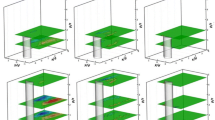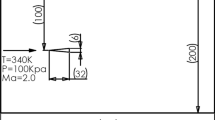Abstract
The three-dimensional orthogonal wavelet multi-resolution technique was applied to analyze flow structures of various scales around an externally mounted vehicle mirror. Firstly, three-dimensional flow of the mirror wake was numerically analyzed by using the large eddy simulation (LES). Then, the instantaneous velocity and vorticity were decomposed into the large-, intermediate-, and relatively small-scale components by the wavelet multi-resolution technique. It was found that a three-dimensional large-scale vertical vortex dominates the mirror wake flow and makes a main contribution to vorticity. Some intermediate- and relatively small-scale vortices were extracted and were clearly identifiable.
Access provided by Autonomous University of Puebla. Download conference paper PDF
Similar content being viewed by others
Keywords
1 Introduction
The aerodynamic noise and vibration caused by the vehicle door mirror has been much studied (Watkins and Oswald 1999), largely by numerical simulation (Ono et al. 1999). It is evident that the aerodynamic noise and vibration are strongly associated with the flow structures, and the unsteady behavior of the vortex causes the wind noise. Recently, the aero-acoustic characteristics of a vehicle door mirror were also studied by numerical simulation as well as experimental measurement (Reichl et al. 2005). Rinoshika et al. (2007) experimentally investigated the flow structure around an externally mounted vehicle mirror by the smoke-wire visualization technique and high-speed PIV technique. It is found that the length scales of separation region are generally insensitive to Reynolds number, and the size of vortices and the vorticity concentration increase with Reynolds number. Rinoshika and Watanabe (2010) also applied one-dimensional wavelet multi-resolution technique to decompose Reynolds stress measured by high-speed PIV into various scales and analyzed the multi-scale flow structures behind a vehicle external mirror. But little attention has been paid to the analysis of the complex three-dimensional turbulent structures of various scales in the mirror wake from either the numerical or measurement data.
This work aims to apply the three-dimensional orthogonal wavelet multi-resolution technique to decompose the complex turbulent structures of the mirror wake into multi-scale structures based on the large eddy simulation and to provide both quantitative and qualitative information on the three-dimensional flow structures of various scales for designing the mirror with lower dynamic drag and noise.
2 Approach of Numerical Simulation
In this study, the commercial CFD software Fluent 6.3 is used to simulate the three-dimensional (3D) unsteady flow-field around a door mirror model. The LES turbulence model is adopted in which small eddies are modeled whereas large eddies are directly calculated.
A 1/3-scaled generic door mirror model, as shown in Fig. 1, is adopted and fixed on a flat plate. For simplifying the complex flows around the door mirror model, the flat plate is assumed to be the car body and the effect of the A-Pillar is neglected. The height of the mirror model is defined as characteristic length with L = 100 mm. The computational domain, in which the model is placed, is shown in Fig. 2, where the length, width, and height of the domains are 6, 2.5, and 2L, respectively. The mesh of the hybrid volume, containing approximately 542,945 cells, is generated in the computational domain.
3 3D Orthogonal Wavelet Transform
Given a three-dimensional data matrix \( V^{N} = \left[ {v_{i,j,k} } \right] \) (i = 1,…,2N; j = 1,…,2N; k = 1,…,2N) having size of \( 2^{N} \times 2^{N} \times 2^{N} \), its coefficients of three-dimensional wavelet transform S can be obtained by
where W is constructed based on a cascade algorithm of the wavelet basis matrix and the permuting matrix for all level transform and satisfies W T W = I, where I is a unit matrix. The inverse orthogonal discrete wavelet transform can be simply performed by reversing the procedure, that is,
In order to obtain the wavelet level components of the transformed data, similarly to one- and two-dimensional wavelet multi-resolution analysis (Rinoshika and Zhou 2005; Rinoshika and Omori 2011), the orthogonal wavelet coefficient matrix S is first decomposed into the sum of all levels:
where \( \varvec{D}_{i}^{N} \) consists of a wavelet coefficient matrix of level i and a zero matrix, having size of \( 2^{N} \times 2^{N} \times 2^{N} \).
The inverse orthogonal wavelet transform is then applied to the coefficient of each level, viz.
where the first term \( \varvec{W}^{T} \varvec{W}^{T} \varvec{D}_{\varvec{1}}^{T} \varvec{W} \) and the last term \( \varvec{W}^{T} \varvec{W}^{T} \varvec{D}_{N - 2}^{T} \varvec{W} \) represent the data components at wavelet level 1 (the highest grouped frequency) and level N-2 (the lowest grouped frequency), respectively. This decomposition method is referred to as the three-dimensional wavelet multi-resolution technique.
4 Spectral Characteristics of Wavelet Components
In order to analyze the three-dimensional flow structures of various scales, a three-dimensional wavelet multi-resolution technique is used to decompose the velocity and vorticity data of LES. The analysis region, as shown in Fig. 2, is focused on a volume of 140 × 140 × 140 mm behind the door mirror, which is divided into a mesh of 64 × 64 × 64. It results in a mesh size of 2.2 mm that represents the spatial resolution of LES.
To determine the scale characteristics of each wavelet component, the u y velocity signal is analyzed by the wavelet multi-resolution technique and is decomposed into three wavelet components. In this study, the instantaneous velocity field (64 × 64 × 64) extracted from LES is first decomposed into three wavelet levels or wavelet components by the three-dimensional orthogonal wavelet multi-resolution analysis. Then, the fast Fourier transform is used to analyze each wavelet component. The spectrum of each wavelet component displays a pronounced peak at a scale called the central scale. The wavelet level 1 having central scale of 16 mm represents the relatively small-scale structures, and the wavelet level 2 having central scale of 29 mm represents the intermediate-scale structure while the wavelet level 3 with central scale smaller than 62 mm refers the large-scale structure.
5 Results and Discussion
To quantify the flow structures around the mirror, the instantaneous velocity and pressure fields are simulated by LES at a constant free-stream velocity of 15 m/s, which corresponds to Reynolds number Re (≡UL/ν) = 105. Figure 3 shows the representative instantaneous streamlines and corresponding vorticity contours, \( \omega_{y} \) in the (x, z)-plane and \( \omega_{z} \) in the (x, y)-plane. Here, the white and black represent positive and negative maximum values of vorticity, respectively. The streamlines and vorticity contours display the quasi-periodical large-scale vortices with opposite sense of rotation shed from the mirror in the separating region in both of the (x, z)- and (x, y)-plane. The large-scale structures are very similar to the Karman vortices of a cylinder wake. The largest vorticity concentration appears in the shear layer, which originates from the shear layer instability. This flow structure appears rather similar to the experimental results based on high-speed PIV (Rinoshika et al. 2007, 2010), thus providing a validation of the LES.
In order to analyze the multi-scale flow structures of mirror wake, the 3D wavelet multi-resolution technique is used to decompose velocity and vorticity behind the mirror (as shown in Fig. 2). Figure 4 shows instantaneous velocity vectors and vorticity magnitude contours \( \left| \omega \right| \) = (\( \sqrt {\omega_{x}^{2} + \omega_{y}^{2} + \omega_{z}^{2} } \)) of the LES and wavelet components in the (x, z)-plane (the plan view). Two large-scale vortices, which originate from the tip and root of the mirror, respectively, are clearly observed at central scale of 62 mm (level 3) in Fig. 4b. They correspond well to the large-scale structures of the LES (Fig. 4a). The vortex near the root is slightly larger than that at the tip. The large-scale vortices exhibit main contribution to the separation region. Besides the large-scale vortices observed in the LES (Fig. 4a), several intermediate-scale vortices shed from the mirror as well as the relatively small-scale ones are clearly identifiable at central scales of 29 mm and 16 mm (level 2 and 3) in Fig. 4c, d. However, the large-scale structures exhibit stronger vorticity concentration.
6 Conclusions
The three-dimensional orthogonal wavelet multi-resolution technique is applied to analyze LES data and the flow structure around an externally mounted vehicle mirror is decomposed into various scales. The following conclusions can be drawn.
-
1.
Three-dimensional velocity and vorticity fields of the LES are decomposed into three wavelet components having large-, intermediate-, and relatively small-scale.
-
2.
The large-scale structure dominates the mirror wake flow and its vorticity concentration makes main contribution. Several intermediate-scale vortices as well as the relatively small-scale ones, which cannot be observed in the LES, are clearly identifiable.
References
Ono K, Himeno R, Fukushima T (1999) Prediction of wind noise radiated from passenger cars and its evaluation based on auralization. J Wind Eng Ind Aerodyn 81:403–419
Reichl C, Krenn C, Mann M, Lang H (2005) Application of numerical and experimental techniques for the aero-acoustic characterisation of a car rear-view mirror. Int J Aeroacoustics 4:185–212
Rinoshika A, Omori H (2011) Orthogonal wavelet analysis of turbulent wakes behind various bluff bodies. Exp Therm Fluid Sci 35:1231–1238
Rinoshika A, Watanabe K (2010) Orthogonal wavelet decomposition of turbulent structures behind a vehicle external mirror. Exp Therm Fluid Sci 34:1389–1397
Rinoshika A, Watanabe K, Nakano M (2007) Experimental investigation of flow structures around a car mirror. Dyn Continuous, Discrete & Impulsive Systems Ser B Applications & Algorithms 14(S8):78–90
Rinoshika A, Zhou Y (2005) Orthogonal wavelet multi-resolution analysis of a turbulent cylinder wake. J Fluid Mech 524:229–248
Watkins S, Oswald G (1999) The flow field of automobile add-ons with particular reference to the vibration of external mirrors. J Wind Eng Ind Aerodyn 83:541–554
Author information
Authors and Affiliations
Corresponding author
Editor information
Editors and Affiliations
Rights and permissions
Copyright information
© 2014 Springer-Verlag Berlin Heidelberg
About this paper
Cite this paper
Rinoshika, A., Zheng, Y. (2014). Three-Dimensional Wavelet Multi-resolution Analysis of Flow Structures Behind a Vehicle External Mirror. In: Zhou, Y., Liu, Y., Huang, L., Hodges, D. (eds) Fluid-Structure-Sound Interactions and Control. Lecture Notes in Mechanical Engineering. Springer, Berlin, Heidelberg. https://doi.org/10.1007/978-3-642-40371-2_10
Download citation
DOI: https://doi.org/10.1007/978-3-642-40371-2_10
Published:
Publisher Name: Springer, Berlin, Heidelberg
Print ISBN: 978-3-642-40370-5
Online ISBN: 978-3-642-40371-2
eBook Packages: EngineeringEngineering (R0)








